| Ashmolean Museum of Art and Archaeology | ||
| PotWeb: | Ceramics
online @ the Ashmolean Museum |
|
|
|||||
| People and their collections | |
| Note: Although this file is designed to be printed out, its exact format will depend on the page setup of your browser. Note: There are six images on this page. |
| Rupert Bruce-Mitford: A Case Study |
| List of Contents |
| What did he do? |
| What was he like? |
| His early life |
| The New Bodleian collection |
| The recording of the site |
| The material culture |
| Documentary evidence |
| Bibliography |
| What did he do? | |
| Rupert Bruce-Mitford's archaeological field-work during the 1937 construction of the New Bodleian Library, Oxford, effectively began a great tradition of medieval archaeology in Oxford. This set a standard for recording medieval finds in Britain that was to last almost to the end of the twentieth century. He later extended his painstaking analytical approach to the analysis of the Anglo-Saxon treasure recovered at Sutton Hoo on the eve of World War II. |

Rupert Bruce-Mitford, graduate of Hertford College, Oxford, wearing military dress at the beginning of World War II (1914-1994) (Courtesy of Margaret Bruce-Mitford) |
| What was he like? |
| He was an energetic man, meticulous in scholarship, with a gift for friendship and an inspiration to several generations of students. In an account of his career, he wrote: `archaeology is not just excavation, the making of discoveries by digging... Apart from the diggers there are the analysts and systematizers of the materials, the interpreters as well as the finders. Some people are both'. Bruce-Mitford's description could almost be a self-portrait. |
| His early life |
| Bruce-Mitford was born of Anglo-Canadian parents at the beginning of the Great War. His father died when he was only four years of age. He was the youngest of four boys and went to school at Christ's Hospital in London. He gained a history scholarship to Hertford College, Oxford, in 1933. |
| The New Bodleian Collection | |
|
After graduating, he spent 1937-8 at the Ashmolean Museum.
During this time builders began to dig a "huge hole, lined with
interlocking sheet piles" at the junction of Broad Street and
Parks Road. This excavation was to provide the foundations and
basement of the New Bodleian Library, a major University development.
Bruce-Mitford organised one of England's first urban "rescue excavations" on this site. Houses and shops had been cleared at the corner of Broad Street and Parks Road for the new building at the very bottom edge of the photograph. The picture shows the site in relation to the pale copper roofs of the Bodleian Library with the Radcliffe Camera and University church in the background. The High Street at the top of the photograph runs east west, parallel with Broad Street. The plan of the site is inverted to illustrate how the Broad Street frontage matches the houses visible at the bottom edge of the contemporary air photograph above. Each tenement had a well dug down through the gravel terrace to the level of the Oxford Clay. The well-bottoms all proved to have fillings of two or three feet of mud. The "mud cylinders were full of broken medieval pottery, handleless jugs, bowls, and odds and ends". |
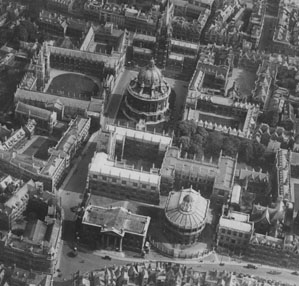 Aerial photograph of the heart of the University;
Broad street running east-west at the bottom of the picture (Allen collection)
Aerial photograph of the heart of the University;
Broad street running east-west at the bottom of the picture (Allen collection)
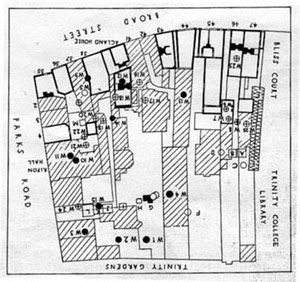 General plan of the New Bodleian site showing the positions of wells and pits
General plan of the New Bodleian site showing the positions of wells and pits
|
| The recording of the site | |
| William Pantin had previously recorded the above-ground archaeology (the vernacular architecture), while Bernard Gotch made a series of watercolours of the site before and during demolition. Bruce-Mitford, sometimes aided by John Daniell, Martyn Jope and S. M. R. Gardner salvaged finds from the builders' excavations. Bruce-Mitford took the spoil back to the Ashmolean where he washed the sherds and attempted to reconstruct the vessels. Later he made drawings of them and published his findings. This resulted in the first-ever modern study of medieval pottery. His chronological sequence of pottery for Oxford has never been challenged, although it has been refined and extended. |
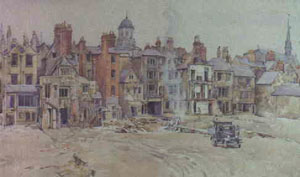
Water colour of the backs of houses nos 35-47 Broad Street, Oxford during the process of demolition, signed Bernard C Gotch (1876-1964) |
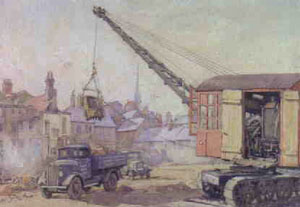
Water colour of lorries and a mechanical digger on the site of the demolition of houses 35-47 Broad Street 1937 by B C Gotch (1876-1964) |
The soil from the site was dropped by mechanical diggers on to lorries. Bruce-Mitford and Martyn Jope remembered sifting through the soil for finds on the lorry journeys as they made their way to the spoil dump. "This was excellent training and experience on the job, thrown in headfirst, dealing all the time with new and original materials. It was also great fun". |
| Material culture | |
| The site of the New Bodleian had been inhabited for more than 700 years. Datable objects recovered from the excavations included a bronze seal-matrix dating to the late 13th or 14th century and a carved bone pocket sundial, possibly imported from Germany in the 17th century. Italianate drinking glasses, an early pair of spectacles and a carved bone inlay from the handle of a fan were recovered from Pit F (see plan). |
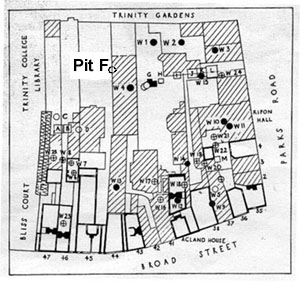 General plan of the New Bodleian site
General plan of the New Bodleian site
|
| Documentary evidence | |
| Written records suggest that some of the material found behind nos 44-45 Broad Street may have come from the rubbish pit of the family house of John Eveleigh, Principal of Hart Hall (from 1604), or possibly that of Richard Wood (from 1685). Wood became mayor of Oxford in 1695. | |
| Bibliography | |
| R. S. L. Bruce-Mitford `The archaeology of the site of the Bodleian Extension, Broad Street, Oxford', Oxoniensia 4 (1939), 89-146. | |
| W. A. Pantin `The recently demolished houses in Broad Street, Oxford', Oxoniensia 3 (1937), 171-200. | |
| M. Biddle `Rupert Bruce-Mitford 1914-1994 Memorial Address', Medieval Ceramics 21 (1997), 119-122. | |
|
© Copyright University of Oxford, Ashmolean Museum, 2000 The Ashmolean Museum retains the copyright of all materials used here and in its Museum Web pages. last updated: jcm/27-jun-2000 |